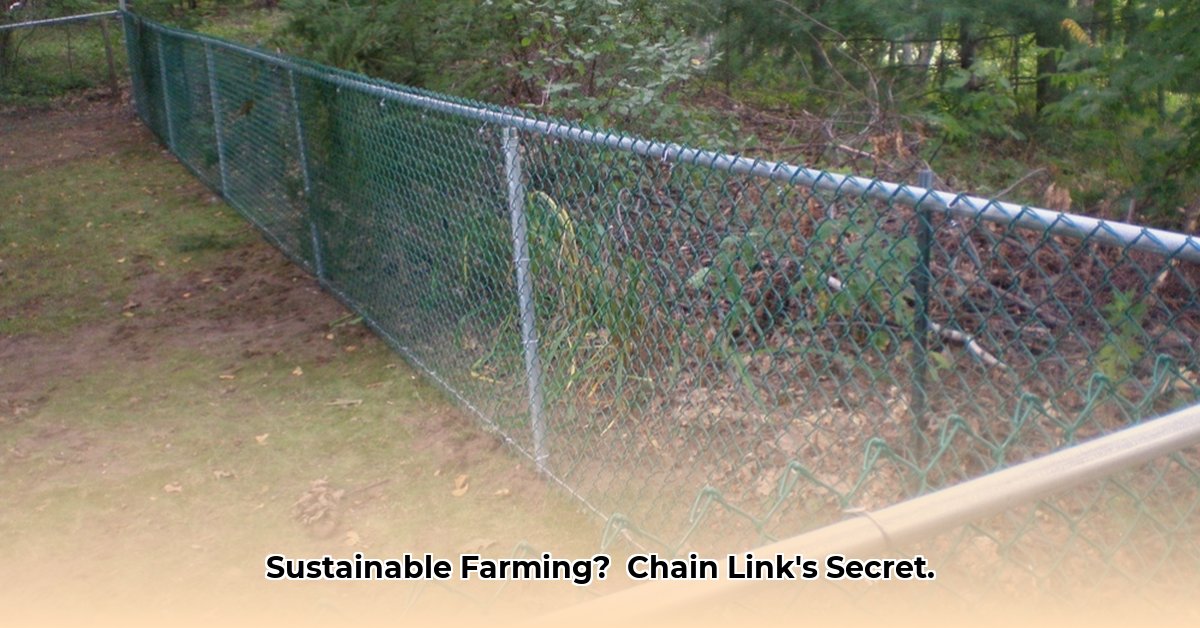
Building a durable and sustainable fence is a critical investment for any farm. This guide focuses on chain link fencing from Tractor Supply, offering a step-by-step approach to selecting, installing, and maintaining a long-lasting, environmentally responsible fence. We'll explore cost-effective options, practical installation techniques, and sustainable practices to minimize environmental impact. For larger projects, check out this chicken coop guide.
Choosing Your Chain Link Fence Materials at Tractor Supply
Selecting the right materials is paramount for a sustainable fence. Consider the long-term costs and environmental impact alongside initial expenses. Tractor Supply offers various options; choosing wisely minimizes waste and saves money.
Wire Thickness (Gauge): Thicker wire (lower gauge number) provides greater strength and longevity, reducing the need for frequent replacements. A heavier gauge wire, while slightly more expensive initially, significantly improves the fence's resistance to damage and weather, extending its lifespan and reducing waste in the long run. Think of it as selecting a sturdy rope instead of a thin string; the thicker option will obviously hold more weight and endure harsher conditions.
Vinyl Coating: A vinyl coating adds protection against rust and weather damage, significantly extending the fence's life. While the upfront cost is higher, the increased longevity reduces the need for frequent replacements, making it a more sustainable and cost-effective option over time. This superior protection also contributes to a more aesthetically pleasing fence.
Hardware: Posts and Fittings: Strong, durable posts and fittings are crucial for overall fence stability and longevity. Opt for galvanized or powder-coated steel to maximize resistance to rust and corrosion. These durable components resist the elements and ensure a longer lifespan for your entire fence. Investing in high-quality hardware provides significant long-term benefits.
Installing Your Chain Link Fence: A Step-by-Step Guide
Proper installation is essential for a long-lasting fence. While seemingly straightforward, attention to detail makes a significant difference. Here’s a detailed step-by-step guide:
Planning and Measurement: Before purchasing any materials, carefully plan your fence layout. Measure the perimeter accurately, considering terrain, existing structures, and access points. This crucial step streamlines the installation process and avoids costly mistakes. A well-thought-out plan saves time and resources.
Setting the Posts: Dig post holes at least three feet deep for superior stability, especially in windy areas. Adding concrete to the holes provides additional reinforcement, preventing shifting or settling over time. This seemingly small detail is crucial for a long-lasting, secure fence that withstands weather extremes.
Tensioning the Wire: Proper tensioning is crucial for a taut and straight fence. Ensure consistent tension across the entire length, preventing sagging and maximizing the fence’s lifespan and effectiveness. Invest time in this critical step – it will significantly impact the fence's overall strength and appearance.
Secure Attachments: Use high-quality clamps and tie wires when attaching the wire to the posts. These secure attachments prevent wire sagging and early wear, contributing to the overall durability of the fence. Choosing quality over inexpensive options here pays off in the long run.
Sustainability: The Long-Term View of Your Chain Link Fence
Sustainable fencing considers the entire life cycle—from material sourcing to disposal. A holistic approach minimizes environmental impact and maximizes long-term value.
Lifecycle Cost Analysis: Don't focus solely on initial cost. Consider installation, maintenance, and eventual disposal costs. A more expensive, durable fence may prove more cost-effective over its lifespan. This broad perspective ensures a financially sound and sustainable investment.
Material Sourcing: Inquire about the origin of the steel used in the chain link. Recycled steel significantly reduces the carbon footprint compared to steel produced from virgin materials. Prioritizing recycled content aligns with environmentally responsible farming practices.
End-of-Life Management: Plan for responsible disposal or recycling. Chain link components are often recyclable, minimizing waste and promoting responsible resource management. Research local recycling options in advance to ensure a seamless and sustainable end-of-life process.
Comparing Chain Link to Other Fencing Options
Chain link offers various advantages, but other options exist. Consider each fence type's pros and cons before making a decision:
| Fence Type | Pros | Cons | Sustainability Considerations |
|---|---|---|---|
| Chain Link | Affordable, durable, relatively low maintenance | Can rust (unless vinyl-coated), less aesthetically pleasing | Material sourcing (recycled content?), end-of-life recyclability. |
| Wood | Aesthetically pleasing, biodegradable | Requires significant maintenance, shorter lifespan, prone to rot | Use sustainably sourced lumber; proper disposal is crucial. |
| Vinyl-coated Chain Link | Durable, low maintenance, aesthetically pleasing | Higher upfront cost, less recyclable than steel | Longevity reduces overall environmental impact; check for recyclability of vinyl. |
| Woven Wire | Durable, flexible | Can be significantly more expensive than chain link | Material sourcing and end-of-life management are key factors. |
The ideal fence depends on your specific needs and priorities. Carefully weigh the long-term costs and environmental impact of each option.
Remember, a truly sustainable fence is durable, responsibly sourced, and recyclable. Your choices today directly influence the sustainability of your farm and the environment for years to come. Ongoing advancements in sustainable agriculture will continue to refine best practices. Stay informed, making conscious choices for enduring environmental stewardship.